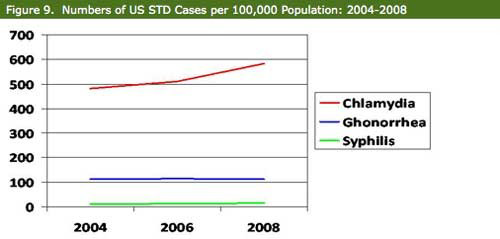Family Functions and Dysfunctions
Families are functional at some levels and simultaneously dysfunctional at others. No two families are exactly alike and very few families experience blissful ideal family experiences. Think about it, how could a family be ideal when its members are mortals?
It can't. Even in the history and myths of ancient civilizations, families had dysfunctions.
For example, Father Abraham's polygamous family had two sons, Ishmael (first-born) and Isaac (second-born). Ishmael and Isaac could not live together because their family broke up as a result of their mothers not getting along (their descendants still hold traditional enmity over these issues). Royal histories are filled with sibling rivalry, incestuous relationships, and violence.
The Roman lore of its founding history includes the fight between two adult brothers over what would eventually become Rome, wherein the twin boys were nearly drowned by their uncle (search Romulus and Remus to be surprised at who these twin's step-mother proved to be). Ancient Greek mythology is also full of family feuding and fighting and discord (search Prometheus, Hercules, Oedipus, and Narcissus). And these characters were assumed to be gods! Again, all modern families have functions and dysfunctions.
Family functions are the tasks and goals that support and sustain the family.
Dysfunctions are failures in the family to accomplish these tasks and goals. Functions are intended. Dysfunctions are typically unintended. For example, family members do not intend to establish poor communication patterns, invisible sexual boundaries (incest), or economic hardships. The basic family functions which are intended include: economic cooperation, control of sexuality, socializing children, identity and social status, and social and emotional need fulfillment.
Figures 1 and 2 show diagrams of how family functions and dysfunctions can be compared to an equalizer on a stereo system. In Figure 1 this family meets the needs of communication, boundaries that are in place and maintained, economic cooperation, nurturance through relationships, raising the child/children, and offering love and support to other family members. Some families meet family members needs better than others.
These are often referred to as being high resource families. There are other families that meet some needs well and other needs poorly.
Figure 2 shows a family that meets most needs poorly. These are called low resource families. This family fails to meet the needs of communication, boundaries that are in place and maintained, economic cooperation, nurturance through relationships, raising the child/children, and offering love and support to other family members. This looks like a hopeless situation, but with voluntary efforts at seeking help or even involuntary efforts (state intervention), more resources could be attained and the family may improve its functionality.
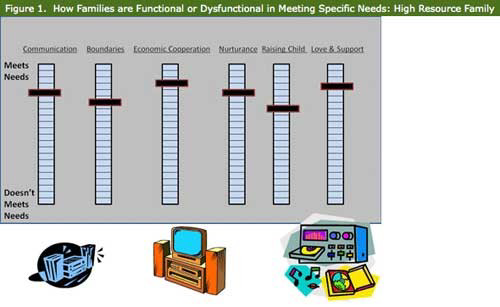
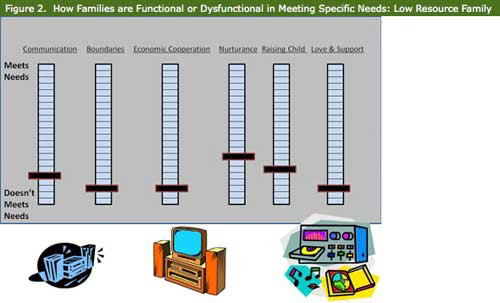
Family dysfunctions can be handed down from generation to generation, with few family members aware that something is wrong in the family system. I know of a 62 year old man who shared with me in private that he was the first in a long line of family members who did NOT sexually abuse other family members. “I broke the chain of abuse,” he declared. His father would not acknowledge the abuse, much less talk to him about his having broken the chain.
Violence and Abuse
Family Abuse is the physical, sexual, or emotional maltreatment or harm of another family member. It is unethical, immoral, and illegal. If you were like me, and you grew up in an abusive home, please accept the fact that it was not your fault. Abuse is perpetrated by powerful people on less powerful people. Young children should be protected by older family members from predators and non-family members who could cause harm. If you were not protected, or worse, if you were preyed upon by someone who was supposed to protect you, then it is their fault not yours!
You may have heard that there is a chain of abuse passed from parent to child to grandchild. That may be true, but not if you don't want it to be in your case. Some estimates place it at 1 in 3 sexually abused children grow up to be abusers. Many abuse survivors are meticulous about marrying non-abusers and about over-protecting their children from potential abusers. Based on my professional and private research in the area of surviving abuse, I'd urge you to seek professional help and support for dealing with your childhood traumas. There are numerous free resources including: http://www.ascasupport.org/; http://www.sexualabusesurvivors.com/; and http://www.providentliving.org/ses/e...2112-1,00.html. Again, it is not your fault. But, healing is your responsibility. It is not enough to simply ignore or deny the abuse. That would be like trying to heal from a 2-inch wood sliver that is lodged in your leg by simply ignoring it.
Sexual abuse is a particularly sinister form of abuse. The American Academy of Child and Adolescent Psychiatry reported that 80,000 cases of child sexual abuse are reported each year in the US with many more cases unreported (retrieved 23 April, 2010 from Child Sexual Abuse, “Facts for Families,” No. 9 (5/08) http://www.aacap.org/galleries/Facts...xual_abuse.pdf). They list possible symptoms:
“Sexually abused children may also develop the following: unusual interest in or avoidance of all things of a sexual nature, sleep problems or nightmares, depression or withdrawal from friends or family, seductiveness, statements that their bodies are dirty or damaged, or fear that there is something wrong with them in the genital area, refusal to go to school, delinquency/conduct problems, secretiveness, aspects of sexual molestation in drawings, games, fantasies, unusual aggressiveness, or suicidal behavior”
Nowhere in this document (or any professional document based on treating survivors) does it blame the victim. Yet, it does urge adult and child survivors of abuse and their family members to seek out professional help and support.
One way to approach child abuse awareness and prevention as a parent or grandparent is to teach your child a simple rule about their safety. Many of the available programs on child sexual abuse prevention use the “No Touch” style of this rule. I teach my students to teach their children this simple rule-no one should touch you where your shirt and shorts cover your body! That is your “no touch zone.” Don't let anyone touch your chest, tummy, hips, buttocks, between the legs, or thighs. If anyone does, then scream “stop!” And tell your mom or dad, teacher, or other trusted adult. There is a useful PDF file on preventing sexual abuse provided by the Centers for Disease Control at http://www.cdc.gov/violencepreventio...hildAbuse.html Now you also have to teach them the difference in a family hug and unwanted inappropriate touch. But, teach it! That's where most parents fail in this regard. They don't want to talk about it (especially if their own wounds are unhealed) and they rarely bring it up. Of special concern to me as the father of 5 sons is the increasing trend of adult female to teen male sexual abuse trends. The news regularly broadcast stories of teachers, teacher's aids, coaches, and mothers of the teen's friends who are seducing and raping teen boys. Most states do not prosecute these abuse cases as they would a male adult to female minor case (often called forcible or statutory rape). Both boys and girls should be protected from sexual misconduct by adults with the threat of felony charges for the adult perpetrator.
Recent US data indicates that there were 3,200,000 alleged cases of child abuse in neglect in 2007 (retrieved 23 April, 2010 from http://www.cdc.gov/violencepreventio...ataSheet-a.pdf). After investigation, about 794,000 were classified as victims. It was reported that 59 percent were neglected, 4 percent suffered emotional abuse, 8 percent suffered sexual abuse, and 11 percent suffered physical abuse. They also reported that girls were slightly more abused than boys (52% to 48%) and that women abused slightly more than men (56% to 42% with some cases the sex of the perpetrator was unknown).
Figure 3 shows child abuse data from 2000-2007 for males, females and total. Again female children were slightly more likely to be abused than males. I find it comforting that the number of substantiated cases declined between 2006-7, but this drop still represents hundreds of thousands of cases. The actual number of cases may be 2 or 3 times that high, since many cases go unreported. Figure 4 shows the specific types of abuse that have occurred. These too are declining yet consistent in their relationship to one another.
Other national studies of child abuse report similar findings (see U.S. Department of Health and Human Services, Administration on Children Youth and Families. Child Maltreatment 2007 [Washington, DC: U.S. Government Printing Office, 2009] available at: http://www.childwelfare.gov.2.Finkelhor, Ormrod, H, Turner, H, Hamby, S. The Victimization of Children and Youth: A Comprehensive National Survey. Child Maltreatment 2005; 10:5-25.3.Theodore, AD, Chang, JJ, Runyan, DK, Hunter, WM, Bangdewala, SI, Agans,R. Epidemiologic Features of the Physical and Sexual Maltreatment of Children in the Carolinas. Pediatrics 2005; 115: e330-e337).
The US now has a national Child Abuse and Neglect Data System (NCANDS) which is designed to gather more accurate data on child maltreatment. Restricted usage files of state case-level data are available for researchers from the National Data Archive on Child Abuse and Neglect at www.ndacan.cornell.edu In addition, aggregated counts of key indicators by State are available for 1990-2007. The Child Maltreatment reports are available on the Internet at http://www.acf.hhs.gov programs/cb/stats_research/index.htm#can” (retrieved 23 April,2010 from http://www.acf.hhs.gov/programs/cb/pubs/cm07/cm07.pdf).
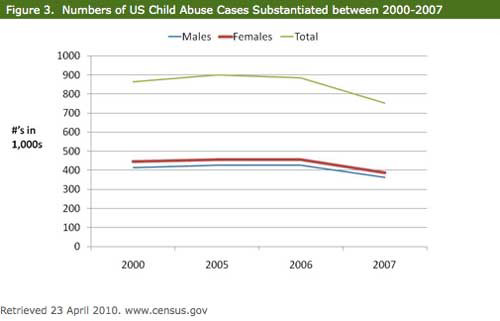
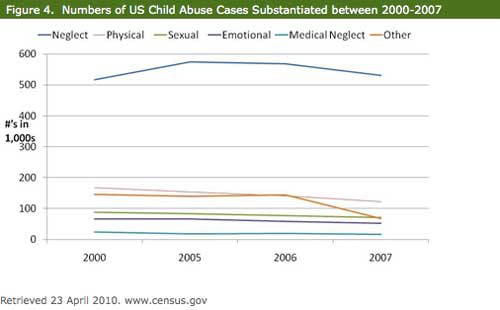
Figure 5 shows the numbers of child abuse victims by their ages. The 18+ category was less than 1,000 cases per year, but it still occurs. Even children who are old enough to vote get abused sometimes. The highest numbers of abuse cases were found among the 2-5 year olds with rates getting lower and lower for the older children. One website reported that 12 percent of high school girls and 3 percent of boys had been sexually abused (retrieved 23 April, 2010 from http://www.rainn.org/getinformation/statistics/sexual-assault-victims).
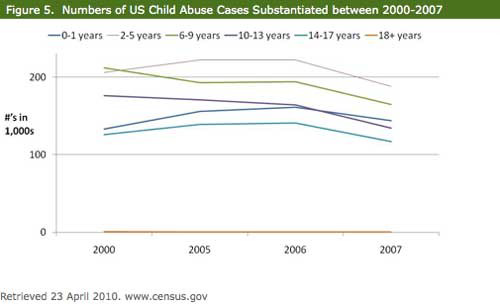
Over half of the reports of child maltreatment came from professionals (57%). This report stated that in 2007 about 1,760 children died, mostly from neglect. The World Health Organization published the “World Report on Violence and Health. In 2000 it was estimated that 57,000 children died from maltreatment worldwide (retrieved 23
April, 2010 from http://www.who.int/violence_injury_p...iolence/global campaign/en/chap3.pdf).
In families, abuse may also be perpetrated by adults against adults. When violence occurs between adult spouses and partners, it is often called intimate partner violence or IPV. The CDC provides a useful definition: “In the context of this document, intimate partner violence (IPV) is defined as actual or threatened physical, sexual, psychological, emotional, or stalking abuse by an intimate partner. An intimate partner can be a current or former spouse or non-marital partner, such as a boyfriend, girlfriend, or dating partner…” (retrieved 23 April, 2010 from http://www.cdc.gov/ncipc/dvp/IPV/IPV...-Screening.pdf). The guidelines in this PDF file focus on frequency of physical, sexual, and emotional abuse which includes a body map to document physical damage.
Questions include: have you ever been (or recently): hit, slapped, kicked, or otherwise physically hurt by someone close to you (partner, spouse, close friend) or has anyone forced you to have sexual activities?
Other assessments ask these questions: are you in danger now, is the perpetrator here with you now, do you have a safe place to go to after the treatment, do you feel in danger, are any children in danger, are drugs and/or weapons involved, and how serious have the threats been?
The US Bureau of Justice Statistics reports crime for each year. In 2007 there were 186,560 crimes perpetrated by spouses and 79,860 perpetrated by ex-spouses. (Retrieved 23 April, 2010 from Criminal Victimization in the United States, 2007 Statistical Tables http://bjs.ojp.usdoj.gov/content/pub/pdf/cvus07.pdf). These included 153,790 assaults by spouses and another 63,650 assaults by ex-spouses. These also included 20,670 rapes and sexual assaults by spouses and another 6,200 by ex-spouses. Quite disheartening was the report that almost 60% of victims did NOT report their crime to police (this is a victimization survey, not just police data). The BJS estimates for 2008 yielded these statistics:
- About 22% of murders in 2002 were family murders.
- Of the nearly 500,000 men and women in state prisons for a violent crime in 1997, 15% were there for a violent crime against a family member.
- Intimate partners were responsible for 3% of all violence against males and 23% of all violence against females in 2008.
- Family violence accounted for 11% of all reported and unreported violence between 1998 and 2002.
(retrieved 23 April, 2010 from http://bjs.ojp.usdoj.gov/index.cfm?ty=tp&tid=94).
In another BJS report for the year 2008, it showed how many cases of violence were perpetrated on males and females and who did the violence (see Figure 6). Females were over 5 times more likely to be attacked by their intimate partner than were males (504,980 female being attacks to 88,120 males being attacked). They were also about twice as likely to be attacked by a relative as males. Males were more likely to be attacked by a friend or acquaintance. The Rape Abuse and Incest National Network reported that 3 percent of men had been victims of attempted rape or rape in their lifetimes and about 1 in every 10 rape victims is male (retrieved 23 April, 2010 from http://www.rainn.org/get-information...ssault-victims). For a comprehensive overview of rape and the related issues of blame see http://freebooks.uvu.edu Chapter 20.
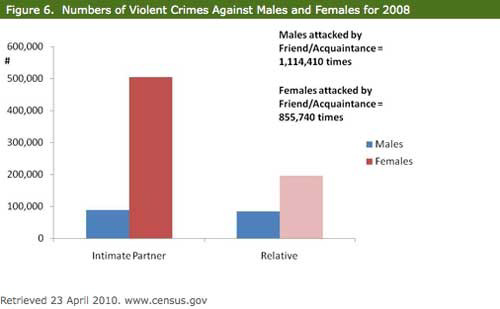
Figure 7 presents family maltreatment on a continuum of violence and control. The red bar represents behaviors considered to be abusive. In families, normal disagreements occur. These are typically not at the degree of violence or control that authorities would become involved. Most parents spank their children. This is a two-edged sword. A spanking can be a simple swat. Used rarely and with low levels of violence and control, this would not concern authorities. The other edge of the sword is that some parents use spanking at high levels of violence and control.
In the name of spanking they, may emotionally, physically and sexually (really rare) abuse their kids. I have a friend who went to a family reunion and was slapped 5 times by an angry sister during the reunion. She was 54 during this event (let me just say something. When I reference my friends, these are true stories. I try to disguise some of the details, but they are real people. To date I have taught more than 13,000 students in university or college. These stories are real). All abuse is emotional or has emotional underpinnings because in families we are emotionally connected to each other and because we all filter experience through our emotions.
I am biased about sexual abuse. Fondling, touching, and sexual intercourse are all violence to me, especially when an adult is perpetrating a child. Even verbal sexual comments are inappropriate. To me, children are to be protected and nurtured, not exploited. The laws of all 50 states concur with this opinion. But, much goes undetected from authorities. There are homes where boys and girls, teens, and even young adults are violated sexually at some level.
In one extreme case in our state, a girl was beaten so severely that she died. Her parents even beat her in her pelvic area and threw her through a sheetrock wall (www.ksl.com).
Hundreds of similar stories were available, yet hers is in the hands of the criminal justice system and out of the public eye (as are so many cases like it). Except that both parents are in prison, to the public, it is forgotten. Physical abuse includes punches, shoves, bullying, etc. It is extremely common and can lead to murder.
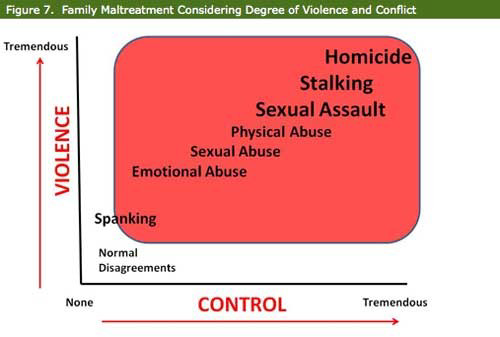
The sexual assault, stalking, and homicide categories of maltreatment are typically considered to be between adults and other adults, but parents do injure children to the point of death. Current spouses, ex-spouses (partners or lovers), and relatives sexually assault, stalk, and/or kill other family members. The first suspect in the murder case of a woman is by default her intimate partner. Once he is ruled out, the police focus on other theories of the crime.
Family violence is common and mostly perpetrated by males on others, but males are also victims of family violence. Even though violent crime have been declining since 1994, males are far more likely to be victimized than females (except in sexual violence).
In less common circumstances women perpetrate violence on men (see Carney M, Buttell F, Dutton D (2007). "Women who perpetrate intimate partner violence: A review of the literature with recommendations for treatment". Aggression and Violent Behavior 12 (1): 108-15). There are networks of shelters for men abused by women and/or other men.
The easiest way for a man to get help is to call 911. There are online resources that can provide information (search shelters for me or go to http://dahmw.org/ for more information).
Spousal and/or intimate partner abuse is extremely concerning to those who try to intervene in family violence. One study using a sample of 16,000 adults in the US, reported that 25 percent of women and 7.5 percent of men had been assaulted by their spouse, cohabiting partner, or date, this data yields estimates of over 2 million intimate partner assaults per year in the US. (Retrieved 23 April, 2010 from Patricia Tjaden & Nancy Thoennes, U.S. Dep't of Just., NCJ 181867, Extent, Nature, and Consequences of
Intimate Partner Violence, at iii (2000), available at http://www.ojp.usdoj.gov/nij/pubs-sum/181867.htm). Scientists at the CDC estimate that there were over $8 billion in medical costs for spousal violence in 1995 and 8 million lost work days (Retrieved 23 April, 2010 from Intimate Partner Violence: Consequences http://www.cdc.gov/ViolencePreventio...sequences.html).
Intimate partner violence use to be called domestic violence. It can be physical, emotional, sexual, threats of violence, or stalking. Stalking is when someone harasses or threatens another repeatedly, even knowing their pursuit is unwanted. Various studies indicate that intimate partner violence is more common among the poor, unemployed, younger parents, and substance abusing partners in society (retrieved 23 April, 2010 from http://www.ojp.usdoj.gov/nij/topics/...nce/causes.htm). The best strategies for intervening include: arrest of the perpetrator, protection orders from courts, prosecution of perpetrators, and batterer intervention programs (retrieved 23 April, 2010 from http://www.ojp.usdoj.gov/nij/topics/...tervention.htm). Unfortunately, the victim often refuses to follow through on pressing charges.
It is very important to understand how violence and abuse transpire in intimate relationships. A 2006 study was published which identified the nature of control and violence between the 2 people involved. The researcher, Michael P. Johnson, reported that four categories emerged:
“Intimate terrorism is where the individual is violent and controlling, the partner is not. In violent resistance, the individual is violent but not controlling, the partner is the violent and controlling one. In situational couple violence, although the individual is violent, neither the individual nor the partner is violent and controlling. In mutual violent control, the individual and the partner are violent and controlling” (retrieved 26 April, 2010 from http://vaw.sagepub.com/cgi/content/a...act/12/11/1003; Violence Against Women, Vol. 12, No. 11, 1003-1018 (2006):Conflict and Control).
In the 1970s, new models emerged which helped professionals understand and intervene in abuse. These models focused on the cyclical nature of abuse (see Walker, Lenore E. (1979) The Battered Woman. New York: Harper and Row). That means abusers typically cycle in and out of violence with their intimate partners. For example, after the relationship becomes established abusers go through a stage of tension and frustration build up. These times are filled with perceived offenses by the perpetrator who begins to define himself as being victimized. Eventually the perpetrator attacks and releases this pent up anger and hostility. Shortly thereafter he feels remorse and reconciles himself to his family member (victim).
Sometimes there is a phase of calm that last until the perpetrator recycles back into the tension and frustration build up stage again, repeating the violent cycle over and over (see Mills, Linda G. Violent Partners: A Breakthrough Plan for Ending the Cycle of Abuse (2008) for more details on how to break the cycle as a victim). Why women and some men stay with their abuser is difficult to explain, but is a major component of successful efforts to intervene. Some have learned that this is part of an intimate relationship-to suffer and forgive. Others stay because they see no economic possibilities if they did leave. Others stay to minimize the relationship break up and the impact the harm of that breakup may cause to their children. Communities have responded to this ongoing problem in multiple ways and at multiple levels. Coordinated efforts have been designed to get police, medical personnel, courts, family, and other social agencies working in the same direction for the best outcomes (reduced abuse). The most common model used today to intervene in domestic violence is called the Duluth Model.
The Duluth Model came in the 1980s from Duluth, Minnesota where an experiment was attempted that united 11 community agencies to reduce violence against women (see http://www.theduluthmodel.org/history.php). This model claims that it is the community that controls abusers (not the spouse), that there are differing types of abuse and each must be responded to in appropriate ways, that socio-economic and historical factors of persons involved must be considered, and that intervention must include perpetrators and victims (Retrieved 23 April, 2010 from The Duluth Model home page at http://www.theduluthmodel.org/duluthmodelonpublic.php).
Critics of the Duluth model point out the absence of counseling and therapeutic efforts.
Other critics argue that it is the court and legal avenues that ultimately protect the victims. Intervention Models often include Duluth and cognitive behavioral therapy plus community intervention strategies. One study found that when considering the most common intervention models, there was really no strong indication that one might be better than the other (Retrieved 23 April, 2010 from http://www.ojp.usdoj.gov/nij/topics/crime/violence-against-women/workshops/batterer-intervention.htm#bips). The Duluth Model and its many variations, when combined with other strategies, are the best way to manage and intervene in family violence cases. One emerging effort designed to encourage abused people to leave the relationship is called the Hope Card Project (see http://www.hopecardproject.com/faq.html). This will help people across municipal jurisdictions to transition away from abusers and into abuse free circumstances.
There is also a concern about the large numbers of elderly abused by younger family members. Family elder abuse is the maltreatment of older family members in emotional, sexual, physical, financial, neglect, and other ways, especially where trust was expected and violated (see http://helpguide.org/mental/elder_ab...al_neglect.htm).
Cooper et al. (2008) estimated that 1 in 4 elderly persons may be at risk for abuse in Western Nations (see Cooper C, Selwood A, Livingston G (March 2008). "The prevalence of elder abuse and neglect: a systematic review". Age Ageing 37 (2): 151-60. doi:10.1093/ageing/afm194. PMID 18349012. http://ageing.oxfordjournals.org/cgi...pmid=18349012.).
The American Association of Retired Persons estimates that $2.6 billion dollars is lost each year from younger persons abusing the finances of the elderly (retrieved 27 April, 2010 from http://bulletin.aarp.org/yourworld/l...st_elder_abuse _during_a_down_economy_.html). The National Center on Elder Abuse reports that Care facilities also work diligently to prevent sexual, emotional, physical, and other forms of abuse by employees and family members. This Center estimates about 2 million elderly who've been abused, even though it admits that there is no uniform system in place to track the abuses (retrieved 27 April, 2010 from http://www.ncea.aoa.gov/ncearoot/Mai...tics050331.pdf).
Marital Stressors
Having a baby, getting a new job, and buying a home are all normative stressors.
Many married couples experience a noticeable decline in marital satisfaction which accompanies the birth of their first child. Judith Wallerstein is quoted as having said, “Each couple must embrace the daunting roles of parents and absorb the impact of her majesty the baby's dramatic entrance while protecting the couples' own privacy” (see The Good Marriage By Wallerstein, J. S. & Blakeslee, S. 1995, Houghton Mifflin: NY).
Many researchers have established a decline in marital satisfaction after the birth of a child, especially the first child. The better the couple are as friends, the less the impact the first child has on their marriage. To transition to the role of parents, it was found that couples who work closely and in a mutually supportive manner make the best adjustments (retrieved 26 April, 2010 from http://www.apa.org/monitor/jan01/parenthood.aspx).
When we bought our first home, we purchased it through friends who were eager to sell and move. They lowered the price for us. Because we got along so well, things went easier for all of us. But, it was by far the most stressful experience of our married lives.
We spent 2 weeks arranging our finances, getting all the legal paper work in order, helping them by keeping appointments with inspectors and closing agents, and beginning to pack our belongings. We simultaneously put our mobile home on the market. The day of the closing, minute details threatened the paperwork so much so that we truly reached the point of believing it through. We eventually signed and succeeded in buying the house. The next day, our home sold and the process of appointments and inspections began from the seller's point of view-then came the move. Our friends moved out. We helped them clean. Then we moved in. We got all of our belongings into the house by about 11:30 at night. The first night in our house we slept on the floor, exhausted to the core of our souls. Buying this house was a huge boon to us. But, even though it was a normal thing for a US family to do, it was very stressful.
Middle families tend to be in their 30-50s, their children are teens or young adults, they are in mid-career, and financially established with a home and cars. Middle families launch children into college, military, and jobs while maintaining steady earnings. They typically have retirement investments and are paying off mortgages and other loans. As they age into their 50s they find that some of their married children return home for a short season because of marital or financial hardships. Parents begin to witness the death of their own parents and siblings and are made much more aware of their pending move into the ranks of the elderly. These families have fewer normative stressors than the younger families.
Elderly families have more freedoms from childrearing than the younger families have.
They are 60 plus and are often grandparents, have their homes paid off, and are looking forward to retirement. Their grandchildren graduate college and become parents in their own right. They have experienced the passing of their grandparents, parents, aunts and uncles, and siblings. They also have begun to face the sober realities of their biological health declines. These families have far fewer normative stressors than younger families.
Acute stressors are typically unexpected, sudden, and demand tremendous resources to cope with them. Bankruptcies, illnesses, crime victimization, loss, and natural hazards are just a few of the acute stressors that could impact a family. Wallerstein and Blakesly (1995) also reported that happily married couples had “confronted and mastered the inevitable crises of life, maintaining the strength of the bond in the face of adversity.”
Stuff happens and some of it is truly acute and stressful.
In the 1970s, two psychiatrists named Thomas Holmes and Richard Rahe developed a scale that measured life stressor that could have impacted an individual or his or her family over the last 3 years (see Holmes, T.H. and Rahe, R.H.: The social readjustments rating scales, Journal of Psychosomatic Research, 11:213-218, 1967, also see another approach from Brown, G.W. and Harris, T.O.: Social origins of depression: A study of psychiatric disorder in women. London: Tavistock, 1978). For families in the young family stage, getting married, having a baby, buying a home, or having a parent die ranked as the most stressful events. For middle and older families, having your spouse die, divorce or separating, moving, and being married were among the most stressful events. In this paradigm one of these events can be coped with fairly well if the family members can gather enough resources to meet the challenge. Two or more acute stressors can pile up into your normative stressors and overwhelm you to the point of illness. This happened to me recently. My father died of cancer, we nearly lost an investment that would have financially ruined us, our married son and his wife moved back home with us then had a baby (they both lost their jobs), I had a car wreck, and I was promoted to Assistant Department Chair. This is on top of all the normal life events we have as parents of three teenagers and employees. As Homes and Rahe predicted, I had surgery.
My life is not that bad compared to our friends. Our best friends from junior college suffered an accident in 1991 when one of their 18 month old twins ran underneath a truck and was instantly killed. This tragic loss impacted them, us, friends, and family. To this day, this has proven to be the most intense stressor they have faced. They survived the loss, but if you were to ask them, it still exists as a tender part of their feelings. How families respond to stresses make a huge difference in their quality of life. Researchers have established that stress can strengthen you or destroy you, depending on how you cope with stressors as individuals or families.
When a series of normal and less significant stressors accumulate it can have the same effect as a major acute stressor. If both happen together, stress can pile up. Stressor pile up occurs when stressful events accumulate in such a manner that resolution has not happened with existing stressors before new stressors are added. Stressor pile up can be detrimental if adequate resources are not obtained to meet the demands of the stressors (search Hill and McCubbin's ABCX Models).
This generation of families does not share the same conservative financial tendencies as did the generation of our grandparents. In the US, many desire to have what they desire now, even if debt has to be incurred to get it. Now-time gratification (also called present time) is the individual perspective that seeks immediate satisfaction of their needs, wants, and desires. Delayed gratification is the individual perspective that has patience, the ability to invest time and efforts now in hopes of a payoff down the road. Delayed gratification is very common among college students who are willing to put in 4-6 years for the promise of a life-long career of better earnings and life experiences.
Bankruptcy often occurs among those who are now-time oriented and fail to wisely manage their resources. A bankruptcy is a federally authorized procedure that allows families (businesses too) to be relieved from liability from its debts and to arrange partial repayments through court ordered relief strategies. The American Bankruptcy Institute keeps track of bankruptcies in the US and report hundreds of thousands of bankruptcies each year (http://www.abiworld.org/AM//Template.cfm?Section=Home). The majority of those are non-business consumer bankruptcies. Chapter 7 (quickest and easiest for business and individuals) and Chapter 13 ( has a built-in repayment plan) are the two most common forms in the US. Bankruptcy does not allow persons to walk away without repercussion.
The 2005 Bankruptcy Abuse Prevention and Consumer Protection Act mandates partial repayments and an 8 year waiting period before refilling (see "Hearing before the Senate Judiciary Committee on Bankruptcy Reform", 109th Cong. February 10, 2005. Retrieved 27 April, 2010). Consumer misspending and mismanagement of funds contribute to a great deal of bankruptcies, but medical bills are often reported as being the cause for half of all bankruptcies in the US (see http://www.theatlantic.com/business/...nkruptcy/4683/).
Medical expenses cost billions to US consumers and can easily bankrupt under-insured and non-insured people. One of these medical concerns includes problematic childbirths.
Over 4 million babies are born in the US each year and only 1 percent were born away from a hospital in 2006 (retrieved 27 April, 2010 from http://www.hhs.gov/news/healthbeat/2...20100329a.html). In 2005 it is estimated that $32 billion was spent on childbirth expenses in the US ( retrieved 27 April 2010 from Big Money: Cost of 10 Most Expensive health conditions Near $500 billion http://www.ahrq.gov/news/nn/nn012308.htm).
Pregnancy and Delivery
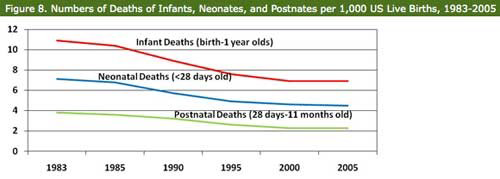
After the 37th week childbirth can happen at any time. There are three distinct stages of childbirth. In the first stage, the cervix in the lowest portion of the uterus (see Chapter 7) begins to dilate and efface. Dilation is the opening of the cervix which stretches the membranes in such a way that effacement or the thinning of the cervix occurs. For the most part, because of contractions of the uterus and muscles surrounding the cervix, the cervix stretches and opens to an undetectable level before the newborn delivers. In the second stage, the baby is pushed down and out, hopefully with its nose facing toward the mother's buttocks and in the head first position. The top back (crown) of the baby's head typically presents first and this is called crowning when it can be seen in the opening of the birth canal. The shoulders deliver first one then the other by lifting then lowering them in such a way as to get one shoulder past the tail bone and the other past the pubic bone. The baby completely exits the mother's body after the shoulders deliver. Once delivered, the baby takes a first breath.
In the third stage, the placenta delivers. If the baby delivers foot or hand first, buttock first, or in any other presentation different from head down and face down toward buttocks, the odds of complications and death increase. The mother also is at risk of complications and death. Some mothers die due to bleeding complications from childbirth (although very rare). The CDC reported that in 2005 12.4 women per 100,000 who gave birth died (retrieved 27 April, 2010 from Health, United States 2009; Table 39 http://www.cdc.gov/nchs/data/hus/hus09.pdf). Caesarian sections (C-sections), or the surgical removal of the fetus form the mother through her abdomen, are common when complications are detected. They are much more intensive in terms of healing for the mother, yet far less risky to mother and baby (see http://www.marchofdimes.com/pnhec/240_1031.asp for more details on C-sections).
During pregnancy a woman will either deliver the baby alive, deliver a baby that died in the womb (still birth), abort the fetus, or miscarry. About 1 in 5 US pregnancies ended in abortion in 2005, or 1.2 million abortions (retrieved 27 April, 2010 from Table 101
Abortions-Number and Rate by State of Occurrence, 2000 and 2005, and Residence, 2005 http://www.census.gov/compendia/stat...es/10s0101.pdf). Miscarriage (also called spontaneous abortion) is the involuntary ending of the pregnancy by the mother's body, typically considered a default process when or if something is abnormal about the fetus or pregnancy. A woman cannot will her pregnancy into miscarriage, nor can she stop a miscarriage simply by changing her attitude.
Table 1 shows the top causes of death for 2006 for the US. The older a person is the closer their age-specific risks of dying match the top 10 cause in Table 1. Please note that smoking/tobacco use is associated with the top 4 causes of disease. The known strategies that can be used to minimize your risk of dying from these diseases are as follows: no tobacco (ever), moderate use of alcohol (or none), regular exercise, healthy diet, sleeping 7-9 hours, manage stress, and plan to be healthy so that the end of your life is less troubled with chronic disorders.
The cause of death most associated with college-aged students (15-34) is as follows: accidents, suicide/murder, cancer, heart disease, and AIDS (HIV). AIDS stands for Acquired Immunodeficiency Syndrome. In the US, AIDS is transmitted mostly from males to males via unsafe sex, but is increasingly transmitted heterosexually between males and females (retrieved 27 April, 2010 from http://hivinsite.ucsf.edu/InSite? page=kb-01-03#S1.5X). World-wide most cases are found in Africa and by far the most common form of transmission is heterosexual unprotected sex and mother-to-child via pregnancy and breastfeeding. Worldwide, AIDS was diagnosed in 33.4 million people in 2008 and about 1,000 children get AIDS each day from their mothers (retrieved from World Health Organization 27 April, 2010 from http://www.who.int/hiv/en/). About 2 million die from AIDS each year, especially in Africa and Asia where most cases are found.
| Table 1: Top Causes of Death in the United States: 2006 |
| 1. Heart Disease at 631,636 |
| 2. Cancer at 559,888 |
| 3. Cerebrovascular diseases at 137,119 |
| 4. Chronic Lower Lung Diseases 124,583 |
| 5. Accidents 121,599 |
| 6. Diabetes Mellitus (adult onset) 72,449 |
| 7. Alzheimer's Disease 72,432 |
| 8. Flu/Pneumonia 56,326 |
| 9. Kidney Problems 45,344 |
| 10. Septicemia (infection of body) 34,234 |
Other Sexually Transmitted Diseases (STDs, now referred to as STIs or sexually transmitted infections) are common among young people. Figure 9 shows the rates of three of the US's most common STDs. In the US, Chlamydia is increasingly occurring and is also the most common STD followed by Gonorrhea then Syphilis (retrieved 27 April, 2010 from http://www.avert.org/stdstatisticusa.htm). Chlamydia is bacteriological and can be cured with antibiotics if detected. The problem is Chlamydia is often asymptomatic (no or very few symptoms). Young women can be permanently damaged in their reproductive system if this disease is untreated.
Gonorrhea and Syphilis can also be treated successfully with antibiotic if treated sooner than later. But, a few resistant strains have been identified which can't be cured with antibiotics at this date. The truly difficult STDs are the viral ones: Hepatitis, Herpes, Human Papilloma Virus (HPV) and AIDS. Once contracted, they remain with the patient for life and are sometimes transmitted to partners and children. Some success has been found in treating symptoms and managing pain, but so far there is no cure. Human Papilloma Virus is also associated with cancers and AIDS because they are often transmitted simultaneously or because people who get one are often having lots of unprotected sex and easily contract another.
